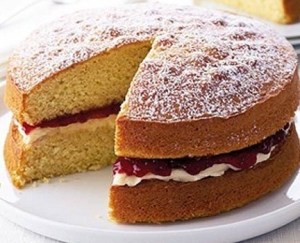Happy Friday folks! Just yesterday over my lovely mid-morning cuppa and slice of cake, I began thinking to myself…just what is the science behind baking the perfect cake? I set about to find out…
First things first, I looked at a recipe for a standard pound cake. It goes like this:
250 g (10oz) self-raising flour
250g (10oz) caster sugar
250g (10oz) butter
Five eggs
Pinch of salt
So, the first thing you must do is beat the butter (this is the fat) and the sugar, and this process is called ‘creaming’. What you are actually doing here is beating lots and lots of air bubbles into the mixture, and all of those bubbles will eventually lead to that lovely light and fluffy texture. The air is carried along the rough surface of the sugar crystals, and is then encased by a film of fat from the butter.
Next you beat the eggs into the mixture. The egg proteins will cover all of those air bubbles, so that when you bake the cake the heat causes the egg to solidify, stopping the fat from melting and the bubbles escaping. If the bubbles escaped the cake would have a very different texture and would fall very flat!
Next you fold in the flour, and because it’s self-raising, it has baking powder included. Folding in the flour ensures you don’t burst any of those all-important air bubbles. The starch within the flour is like scaffolding, holding the egg-coated air bubbles together and giving the cake structure. The baking powder, when added to the wet ingredients, releases carbon dioxide, making the bubbles even larger. That’s what makes the cake rise and become big, soft and fluffy! The pinch of salt adds a little something extra to the flavour.
Next you pour the mixture into cake tins and bake at 180⁰C for 25 to 30 minutes. Heat transfers from the oven to the cake, and the air bubbles in the mixture start to expand. This is firstly due to the heat, called thermal expansion, secondly water vapour begins to form, expanding the bubbles even more, and carbon dioxide from the baking powder is being released. As it gets hotter, the starch granules from the flour absorb water and expand, and the egg proteins coagulate (this means they change to a solid form). At this point, which is around 80⁰C, the cake structure is held in place.
Lastly in the cooking process the Maillard reaction occurs, which basically means the cake is going nice and brown! This also gives the cake it’s lovely cooked flavour. If you touch the cake and it springs back, it’s all ready to come out of the oven and left to cool down.
So there you have it folks; the science behind a deliciously light and fluffy cake. How you ice it and eat it is up to you. Happy baking!
Sources: http://www.thenakedscientists.com/HTML/content/interviews/interview/1817/
http://www.guardian.co.uk/science/blog/2010/jun/09/science-cake-baking-andy-connelly

Leave a comment